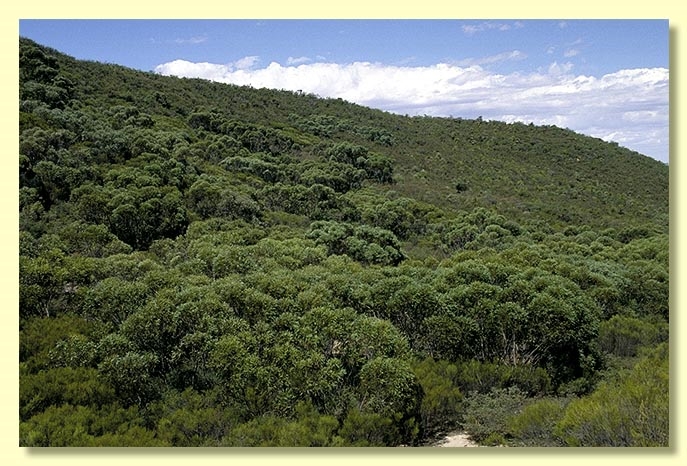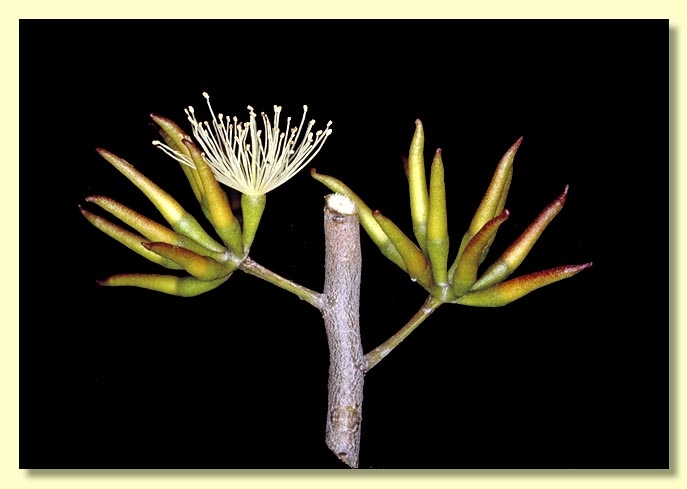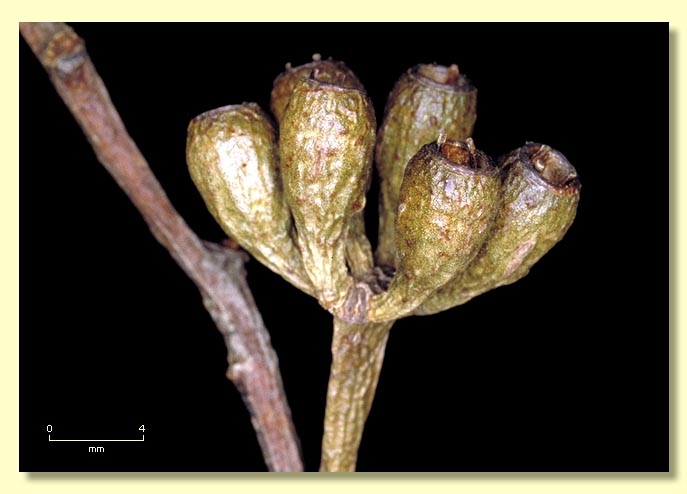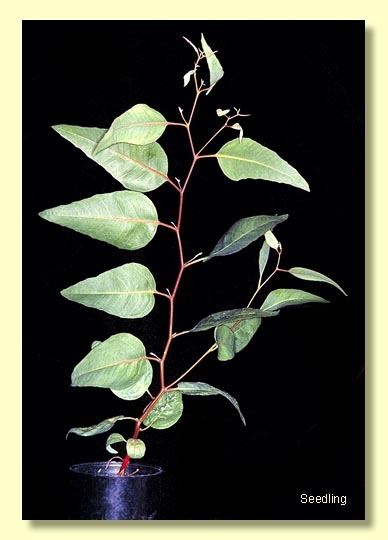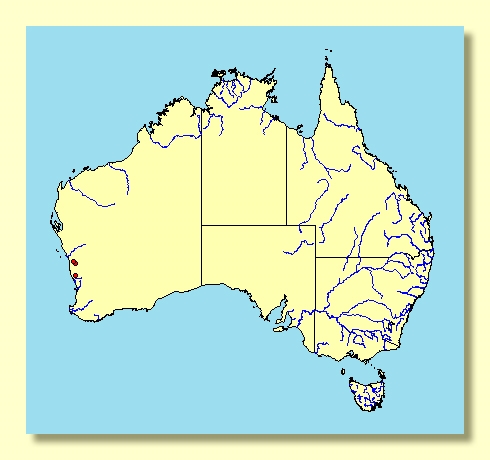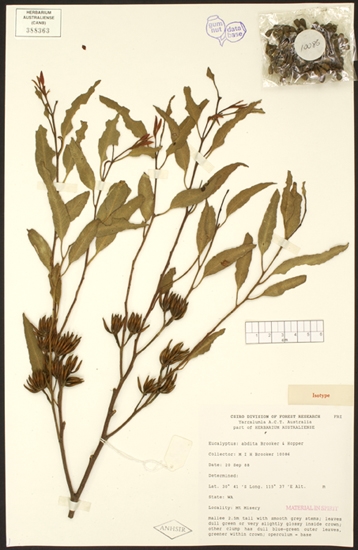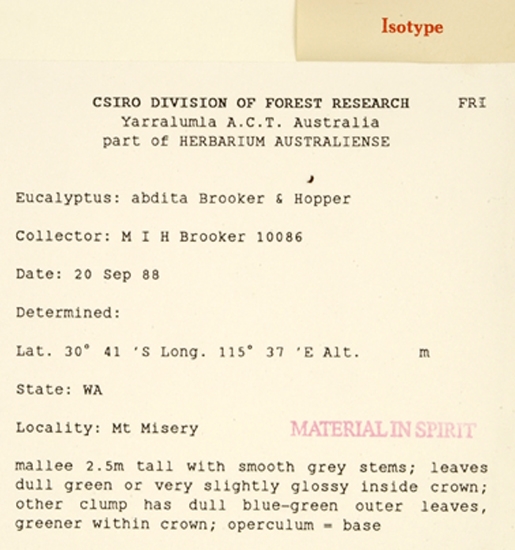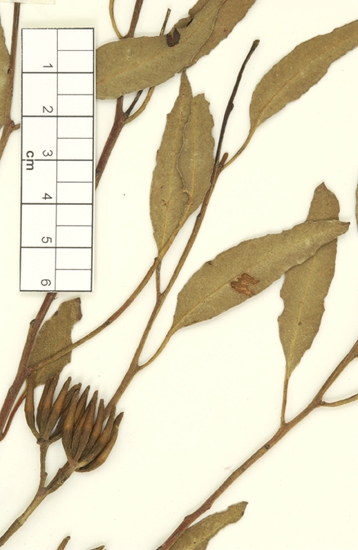Eucalyptus | Symphyomyrtus | Bisectae | Glandulosae | Levispermae | Cubiformes
Euclid - Online edition
Eucalyptus abdita
Bark smooth throughout, grey.
Branchlets with sparsely glandular pith.
Juvenile growth (coppice or field seedlings to 50 cm): stems square to rounded in cross-section; juvenile leaves always petiolate, opposite for 3 or 4 nodes then alternate, ovate to deltoid, 8.2–11.6 cm long, 4–6 cm wide, base truncate, rounded or tapering to petiole, margin entire or slightly irregular, green to bluish green.
Adult leaves alternate, petioles 1–2 cm long; blade lanceolate, 5.5–8(10) cm long, 1.1–1.8 cm wide, base tapering to petiole, margin entire, apex pointed, concolorous, newer leaves dull, blue-green, older leaves green and slightly glossy, side-veins greater than 45° to midrib, reticulation dense, intramarginal vein remote from margin, oil glands mostly intersectional.
Inflorescence axillary unbranched, peduncles widening apically 0.8–1.5 cm long, buds to ?13 per umbel, pedicellate (pedicels 0.2–0.4 cm long). Mature buds fusiform and often curved (1.1–2.1 cm long, 0.25–0.4 cm wide), scar present, operculum conical, to about twice the length of the hypanthium and equal to it at the join, very few outer stamens completely erect, most stamens are deflexed to varying degrees, anthers oblong, dorsifixed, dehiscing by longitudinal slits, style long and straight, stigma rounded, locules 3, the placentae each with 4 vertical rows of ovules. Flowers white.
Fruit pedicellate (pedicels 0.3 cm long), cylindrical to barrel-shaped, 0.6 cm long, 0.4–0.5 cm wide, disc descending vertically, valves 3, near rim level.
Seeds straw-coloured, 0.8–1.5 mm long, sub-spherical, surface smooth, hilum ventral/terminal.
Cultivated seedlings (measured at ca node 10): cotyledons bisected (Y-shaped); stems rounded to square in cross-section; leaves always petiolate, opposite for 2 or 3 nodes then alternate, ovate to narrowly deltoid, 5–7 cm long, 2.5–4 cm wide, base truncate, lamina green, becoming glossy by ca node 7.
Flowering has been recorded in February.
A mallee endemic to Western Australia, of disjunct distribution, occurring north of Perth, where it is known only from Mt Misery near Dandaragan and north-west to Mt Peron and north to Three Springs. It has smooth bark and greenish leaves becoming slightly glossy with age.
Eucalyptus abdita belongs to Eucalyptus subgenus Symphyomyrtus section Bisectae subsection Glandulosae because the cotyledons are bisected, buds have an operculum scar and the branchlets have oil glands in the pith. Within this subsection E. abdita is one of a group of 14 species that form series Levispermae subseries Cubiformes, characterised by having smooth almost cuboid to sub-spherical seed (not spherical), flattened peduncles that widen apically and buds that are narrowly fusiform with some stamens erect and others variably deflexed.
E. abdita may be confused in the field with E. pluricaulis, a species with bluish green leaves that remain dull and with longer, narrower buds and yellowish flowers. E. abdita differs from E. wandoo in its mallee habit.

